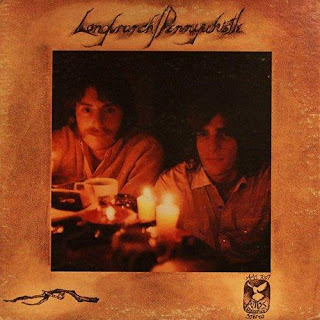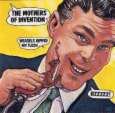domingo, 14 de março de 2021
Caravan - Caravan 1968
For their first album, Caravan was surprisingly strong. While steeped in the same British psychedelia that informed bands such as Love Children, Pink Floyd, and Tomorrow, Caravan relates freedom of spirit and mischief along the lines of Giles, Giles & Fripp or Gong. The band's roots can be traced to a British blue-eyed soul combo called the Wilde Flowers. Among the luminaries to have passed through this Caravan precursor were Robert Wyatt, Kevin Ayers, and Hugh Hopper, and Brian Hopper (pre-Soft Machine, naturally). By the spring of 1968, Caravan had settled nicely into a quartet consisting of Pye Hastings (guitar/bass/vocals), Richard Coughlan (drums), David Sinclair (organ/vocals), and Richard Sinclair (bass/guitar/vocals). Inspired by the notoriety and acclaim that Soft Machine encountered during the burgeoning days of London's underground scene, Caravan began a residency at the Middle Earth club. Additionally, the band was shopping a homemade demo tape around to local record companies. Before long, entrepreneur Tony Cox worked out a deal for them to record on the newly founded U.K. division of the Verve label. Caravan's self-titled debut is equally as inventive and infinitely more subtle than the Soft Machine's Volume One or Pink Floyd's Piper at the Gates of Dawn. Two of the album's best tunes -- the ethereal "Place of My Own" was backed with the dreamlike "Magic Man" -- were issued as the band's first single. Those tracks accurately exemplify the subtle complexities that Caravan would hone to great effect on later recordings. The same can also be said for album cuts such as "Love Song With Flute" and the extended nine-minute "Where but for Caravan Would I?" The latter title aptly exemplifies Caravan's decidedly less than turgid attitude toward themselves -- a refreshing contrast from the temperamental and serious Art School approach adopted by Pink Floyd and the Moody Blues. The mono and stereo mixes of the long-player are striking in their disparities. The stereo mix is at times opaque and virtually swallows the vocals most specifically on the tracks "Policeman" and "Grandma's Lawn." Otherwise, there are numerous additional nuances that discern the two. The single version of "Hello Hello" is also included as a bonus. This track was the follow-up 45 to "Place of My Own" and would appear in a slightly different form on their next LP, If I Could Do It All Over Again, I'd Do It All Over You. Potential consumers should note that the sound quality on this package is indescribably better than the HTD Records 1996 CD pressing. AMG.
listen here
Marc Benno - Lost In Austin 1979
Marc Benno came up playing guitar in various bands in Austin, TX, in the late '60s, then moved to Los Angeles, where he hooked up with Leon Russell and formed the duo Asylum Choir, which released one album in 1968 and recorded a second before splitting up. (The second Asylum Choir album was released in the wake of Leon Russell's commercial success in 1971 and hit #70 in the charts.) He made four albums of mainstream pop/rock in the 1970s, the most successful of which was the third, Ambush, in 1972. AMG.
listen here
Stealers Wheel - Ferguslie Park 1974
Ferguslie Park was recorded after a dizzying string of changes in Stealers Wheel -- co-founder Gerry Rafferty's exit soon after finishing the group's first LP, his replacement by Luther Grosvenor and the delayed climb of "Stuck in the Middle with You," Rafferty's return, and the firing of all involved and the reduction of the group to its founding duo of Rafferty and Joe Egan. The resulting album, recorded with some nine support players (including ex-Herd members Gary Taylor and Andrew Steele, plus guitarists Joe Jammer and Bernie Holland), conductor/arranger Richard Hewson in support, and Jerry Leiber and Mike Stoller producing, is an upbeat if somewhat less focused work than its predecessor -- the mix of hard rock ("What More Could You Want") and lean, melodic songs ("Good Businessman") highlighted by lush choruses, and augmented with occasional spacy digressions such as the shimmering percussion-based interlude between "Wheelin'" and "Waltz (You Know It Makes Sense)," makes this a surprisingly diverse body of music. There wasn't a hit single to be found here, however, which meant that listeners had to find the album on their own; there are moments that anticipate (albeit distantly) Rafferty's solo work, including some well-placed sax breaks, and also jagged, bluesy guitar in all sorts of unexpected places, such as behind the tuneful organ on "Blind Faith" (and the "Shakin' All Over" riff even makes a veiled appearance on "Good Businessman"). AMG.
listen here
Jimmy Hughes - Steal Away - The Early Fame Recordings 1964
Jimmy Hughes established producer Rick Hall's fledgling FAME Studios as an R&B mecca with his 1964 blues ballad "Steal Away." The ex-gospel singer hooked up with Hall in 1962, but it wasn't until the explosive "Steal Away" was issued that his career took off. With an intense, crying vocal style that was perfect for deep soul ballads, Hughes also scored with the pleading "Why Not Tonight" in 1968, and the atypically uptempo "Neighbor, Neighbor" proved another giant hit. Hughes broke away from Hall and recorded an album for Volt before retiring from performing in the early '70s. AMG.
listen here
listen here
Longbranch Pennywhistle - Longbranch Pennywhistle 1969
Longbranch Pennywhistle's only album is mostly of interest to collectors and intense Eagles fans, as it features Glenn Frey and J.D. Souther collaborating before either had risen to fame. It's more low-key and less slick than the Eagles -- than even the early Eagles records, in fact -- but undeniably also lacks the pop hooks that made the Eagles successful stars from the git-go. Sometimes there's a rollicking boogie or bar band rock flavor that works against the pair's primary strengths, which were their easygoing country-rock harmonies. It's best on the folkiest ballads, the standout number being "Mister, Mister." The most famous song on this minor early country-rock LP, however, is "Kite Woman," which Souther would do again for his early-'70s solo debut album. AMG.
listen here
listen here
Creedence Clearwater Revival - Bayou Country 1969
Opening slowly with the dark, swampy "Born on the Bayou," Bayou Country reveals an assured Creedence Clearwater Revival, a band that has found its voice between their first and second album. It's not just that "Born on the Bayou" announces that CCR has discovered its sound -- it reveals the extent of John Fogerty's myth-making. With this song, he sketches out his persona; it makes him sound as if he crawled out of the backwoods of Louisiana instead of being a native San Franciscan. He carries this illusion throughout the record, through the ominous meanderings of "Graveyard Train" through the stoked cover of "Good Golly Miss Molly" to "Keep on Chooglin'," which rides out a southern-fried groove for nearly eight minutes. At the heart of Bayou Country, as well as Fogerty's myth and Creedence's entire career, is "Proud Mary." A riverboat tale where the narrator leaves a good job in the city for a life rolling down the river, the song is filled with details that ring so true that it feels autobiographical. The lyric is married to music that is utterly unique yet curiously timeless, blending rockabilly, country, and Stax R&B into something utterly distinctive and addictive. "Proud Mary" is the emotional fulcrum at the center of Fogerty's seductive imaginary Americana, and while it's the best song here, his other songs are no slouch, either. "Born on the Bayou" is a magnificent piece of swamp-rock, "Penthouse Pauper" is a first-rate rocker with the angry undertow apparent on "Porterville" and "Bootleg" is a minor masterpiece, thanks to its tough acoustic foundation, sterling guitar work, and clever story. All the songs add up to a superb statement of purpose, a record that captures Creedence Clearwater Revival's muscular, spare, deceptively simple sound as an evocative portrait of America. AMG.
listen here
listen here
East Of Eden - Mercator Projected 1969
East of Eden's debut LP is one of the hardest rocking albums to come out of the progressive rock movement, and maybe the best non-Rolling Stones albums issued by English Decca during all of the late 1960s. It's also one of the most daring debut albums of its period, less tightly focused than, say, King Crimson's Court of the Crimson King but otherwise equally bold and maybe more challenging. The whole record is eerie -- coming from a pop culture where most psychedelic rock tended toward the light and airy -- the way the high-impact bass, drum, and guitar parts interact with the distinctly Oriental and Central/Eastern European classical influences. The title track is a surprise coming from any British psychedelic band of the period, opening with a pounding heavy metal beat pumped out on Steve York's bass and Dave Dufort's drums, while Dave Arbus' electric violin subs for what would normally be the rhythm guitar part and Geoff Nicholson's guitar twists a blues riff around before setting a Jimi Hendrix-like wave of tonal pyrotechnics ablaze for the finale. Though most of the rest isn't as hard rocking as that, it is still progressive rock with balls. "Isadora" may have a few flute flourishes too many, but it also has a beat, and "Waterways" (described on the original jacket as "Niotic Landscape in 5/4"), after a meandering opening, breaks loose in a hard-edged piece of heavy metal raga rock (with a sax part that fits in perfectly), something like what the Yardbirds might've attempted if they'd stayed together through 1969 and forsaken their pop pretensions -- and then it finishes with the kind of brooding, violin-based ballad that anticipates the 1973-era David Cross/John Wetton/Bill Bruford lineup of King Crimson. And "Centaur Woman" takes us back to almost a mid-1960s blues-rock mode, reminiscent of the Graham Bond Organization, except that East of Eden quickly kicks out the song structures, taking Coltrane-like sax excursions before throwing in an extended bass guitar solo. Side two of the album opens with the brooding "Bathers," perhaps the most conventional progressive cut on this album and, not coincidentally, the least interesting song here. "Communion," by comparison, is a composition whose inspiration was a Bartok string quartet, and is dominated by Arbus' violin. The album finishes with the high-energy "In the Stable of the Sphinx," a blazing showcase for electric guitar, violin, tenor, and alto sax that's worth the price of admission by itself and must've been amazing to hear on stage. Mercator Projected was reissued on CD in Japan in 2000 as part of the British Rock Legend Series by Universal Music Group. AMG.
listen here
Subscrever:
Comentários (Atom)







